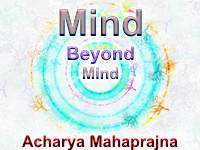
Does self-watchfulness amount to Samvara (stopping of the operation of Karma) or Nirjara (breaking of the vicious circle of Karma)?
It is both. The self-watchful man plugs the doors through which the particles of Karma enter into the soul. Once the doors have been shut, the inflow of Karma particles will be stopped. This gives the strength, which enables us to wipe out the effects of earlier Karma from the soul. This is called Nirjara.
Is not inaction also a kind of action?
Inaction is also a kind of action. Even the attempt to renounce action is action.
Do we feel hungry because we have knowledge or are there any other cause of it?
If knowledge were the cause of hunger, even the emancipated souls will feel hungry. If hunger were caused by ignorance, even the inanimate things will feel hungry. Neither knowledge, nor ignorance is the cause of hunger. We feel hungry only when the current of knowledge gets mixed with action based on feeling.
What is the difference between feeling and feeling the self?
Feeling is born when the current of knowledge gets mixed up with passions. When knowledge, action, and predilections get mixed together, they produce feeling, but the state in which we feel the self is a state of knowledge or pure consciousness. Feeling the self is self-consciousness. It is an experience of the self.
What do you mean by Jnana-Cetana (consciousness-cum-knowledge) and Kasaya-Cetana (consciousness-cum-passions)?
Two circles, the circle of knowledge, and the circle of passions surround the soul. Both have their own inherent force. These two forces' clash with each other. Pure consciousness possesses eternal peace and possesses its own strength. It throws rays of knowledge outwards. The rays of passions try to placate the rays of knowledge. The result is a collision. The currents of knowledge possessed by a self-watchful person try to push aside the currents of passions and to break the circle described by them. In this clash the stronger current will win. The clash between the two currents is like a seesaw battle. Sometimes the current of passions will eclipse the current of knowledge and at other times the current of knowledge will push aside the current of passions and destroy it completely.
How can we strengthen Japa?
There are four factors, which make Japa strong and effective, colour, sound, pronunciation of words, and the combination of these three with the mind. While reciting the Mantra 'Namo Arihantanam' we should concentrate on the white colour. The term Arhat associated with whiteness, the term Siddha with redness, the term Ariyanam with the yellow colour, the term Uvajjhayanam with the blue colour and the term Loe Savvasahunam with the black colour. Every Mantra has its own colour. Every letter is also associated with a particular colour, smell, taste, touch, and a particular sound point in the body.
What is subtle or mental Japa?
Subtle Japa or recitation is not articulated. Articulation is a gross thing. There are three kinds of Japa and mental or subtle Japa is one of them. It is also spoken of as Hrdaya Japa or Rahasya Japa or Gudha Japa. Suppose you have chosen the heart as the concentration point. This is the simplest point. Now take a sentence from the Mantra or the letters representing the ideal. Close your eyes and try to visualise the letters. You will visualise these letters in the golden colour. You will simply repeat the letters without pronouncing them in a state of concentration. This is called subtle concentration. The Japa performed in this manner is a very powerful Japa. If you read the letters aloud the Japa will not be so effective. Mentra Japa consists in only visualising the letters in a state of concentration. This Japa strengthens the mind. During this Japa you have to keep the eyes wide open.
Does every ideal have its own body point of concentration?
The Mantra 'Namo Arihantanam' can be recited by concentrating on several points in the body. We perform a Japa with a certain purpose. There are different concentration points for different purposes. You may have several purposes and every purpose has its own body point.
What should be the procedure of Japa, if you want to feel that the body is distinct from the soul?
To repeat the feeling that the body is distinct from the soul is not less beneficial than any other kind of Japa. It is a very effective Mantra to break delusion. You may recite the sentence aloud. The following is the procedure. First make a sharp and prolonged sound. Ft should be done in the short, long, and medium pitches. A performance for ten fifteen minutes will relax the body and make it feel tired. Stop the recitation after ten fifteen minutes. Then begin an Upansu Japa, which means recitation with a simple vibration of the lips without producing any audible sound. Perform this for another ten fifteen minutes and then pass over to mental Japa. If you follow this order, it will give you strength. In mental Japa you are not to pronounce any part of the Mantra either in a low or high pitch. You will simply recite silently and go on seeing with wide-open eyes. You will be a mere spectator.
 Acharya Mahaprajna
Acharya Mahaprajna

